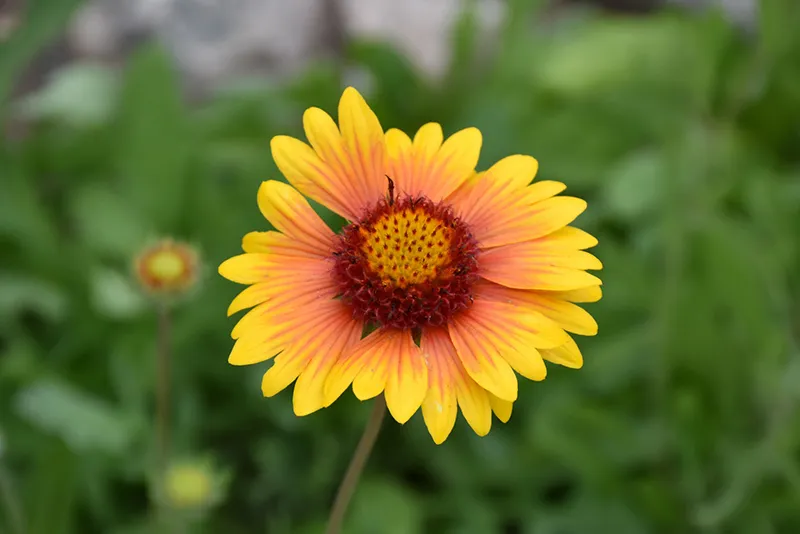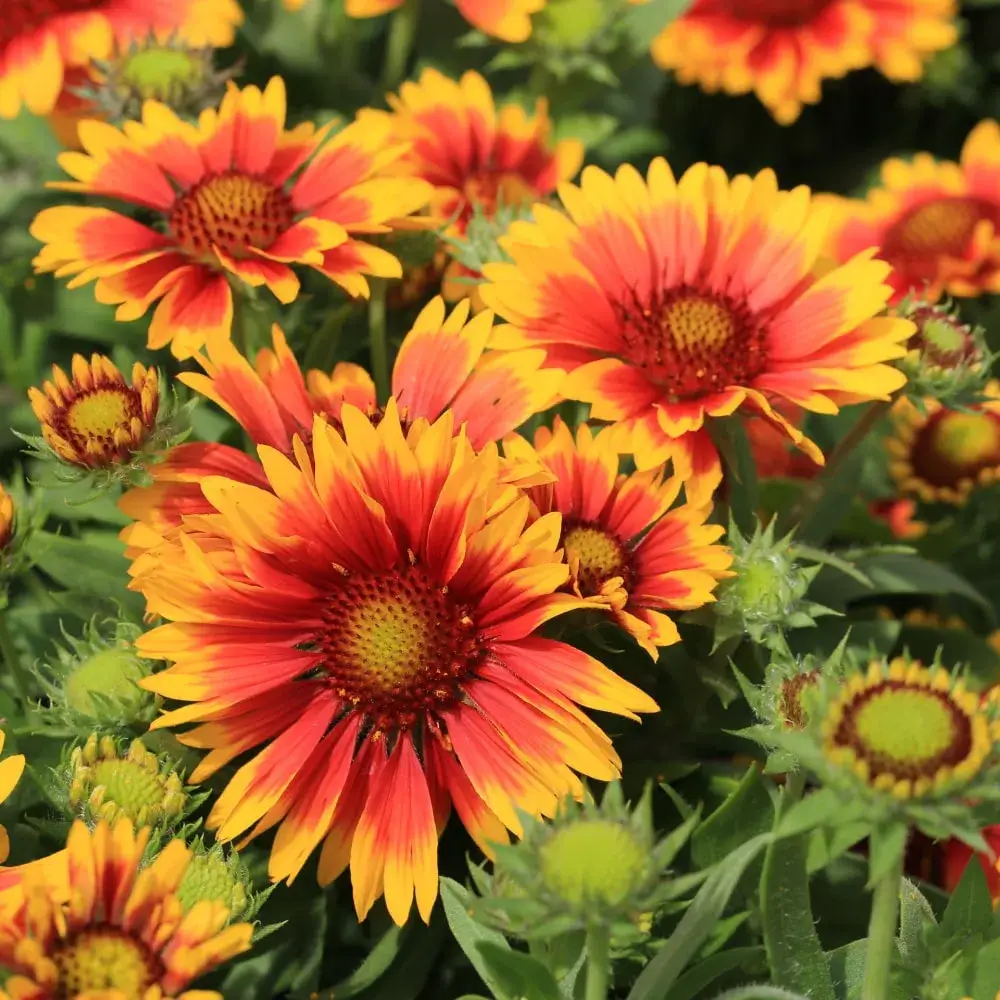Family: Blanket Flower
Type: Perennial
Other Common Name: Blanketflower, Indian Blanket

Blanket Flower, scientifically known as Gaillardia, is a vibrant and hardy perennial. It is celebrated for its richly colored, daisy-like flowers and long blooming season.
This plant is a low-maintenance choice, thriving in a variety of conditions. It’s particularly known for its tolerance to poor soils and drought, making it a resilient addition to any garden.
Blanket Flowers are great for adding bursts of color from early summer to fall. Their blooms come in shades of yellow, orange, red, and combinations thereof, attracting butterflies and bees.
Hardiness Zone: 3a-9a
Deer Resistant: Yes
Pet Friendly: Yes
Moisture Preference: Dry to average
Sun Needs: Full sun
Drought Tolerance (Xeriscape): Yes
Growth Rate: Fast
Average Height (feet): 2.5
Average Spread (feet): 1.5
Average Life Span (years): 5
Form: Mounded
Flower Color: Orange
Secondary Flower Color: Red
Flower Eye Color: Burgundy
Flower Shape: Daisy
Bloom Season: From early summer to mid fall
Foliage Color: Green
Foliage Shape: Narrow
Incorporating Blanket Flower into your landscape offers a splash of color and textural interest. Its bright, bold flowers can become a focal point in any garden setting.
Use them in borders, as part of a mixed perennial bed, or in wildflower gardens. Their versatility and easy-care nature make them suitable for various landscaping designs.
These flowers are ideal for xeriscaping due to their drought tolerance. They add color and life to low-water garden designs without requiring extensive care.

Blanket Flowers fit beautifully in cottage gardens. Their informal growth habit and colorful blooms add to the charming, relaxed feel of this garden style.
In prairie or meadow gardens, Blanket Flowers contribute to the natural, wild look. They mingle well with grasses and other native perennials, enhancing the prairie aesthetic.
For a contemporary garden, Blanket Flowers offer a pop of color against more structured elements. Their bright colors can provide striking contrast in modern, minimalist designs.
Plant in groups for a bold display. Mass plantings create a sea of color that’s visually striking and highly attractive to pollinators.
Pair with ornamental grasses. The combination of fine grass textures and bright Blanket Flower blooms creates a dynamic visual contrast.
Use as a border along walkways or fences. Their medium height and colorful blooms make them perfect for lining pathways or garden boundaries.
Select our pre-made garden layouts to create a landscape that’s uniquely yours. Simple, smart, and customizable!
In spring, Blanket Flower starts to grow, setting out green foliage as a base for the upcoming vibrant blooms that will appear in early summer.
During summer, Blanket Flowers are in full bloom, showcasing their bright, cheerful colors. They become a highlight in the garden, attracting butterflies and bees.
In fall, the blooms may begin to fade, but the plant often continues to flower until the first frost. The foliage starts to die back as the plant prepares for winter.
In winter, Blanket Flower goes dormant. The above-ground parts of the plant die back, but it will re-emerge with vigorous growth and color the following spring.
Blanket Flower thrives in an area with full sun. Choose a spot in your garden that receives at least six hours of direct sunlight daily for optimal growth and blooming.
Full sun exposure is crucial for Blanket Flower. It ensures the most vibrant blooms and healthiest growth. Partial shade can reduce blooming and dull the vibrancy of the flowers.
Well-drained soil is essential for Blanket Flower. It can tolerate poor soil conditions, including sandy and rocky soils, but does not do well in wet, heavy soils.
Space Blanket Flower plants about 12 to 18 inches apart. This spacing allows for proper growth, air circulation, and helps prevent disease spread among plants.
Plant Blanket Flowers in the spring after the danger of frost has passed. This timing allows the plant to establish roots before the heat of summer.
Dig a hole as deep as the root ball and twice as wide. Place the plant in the hole, backfill with soil, and water thoroughly. Mulching can help retain moisture and suppress weeds.
Water Blanket Flowers regularly after planting until they are established. Once established, they are drought-tolerant and only need watering during prolonged dry spells.
Apply a light, balanced fertilizer in the spring. Avoid over-fertilizing, as this can promote foliage growth at the expense of flowers.
Deadhead spent blooms to encourage more flowering. In late fall or early spring, cut back the foliage to promote healthy new growth.
In spring, remove any dead foliage and apply a balanced fertilizer. Water as needed to encourage growth, especially in dry conditions.
During summer, Blanket Flowers require minimal care. Water them during extended dry periods and deadhead regularly to promote continuous blooming.
In fall, reduce watering as the plant prepares for dormancy. You can leave the seed heads for winter interest and to provide food for birds.
In winter, Blanket Flower is dormant. If you didn't cut back the plants in the fall, you can do so in late winter. Mulching can protect the roots in colder climates.
Blanket Flower typically blooms from early summer to fall, especially when deadheaded regularly to encourage continuous flowering.
Yes, Blanket Flowers are perennials. They will return each year and can spread to fill in garden space over time.
Yes, Blanket Flowers can be successfully grown in containers as long as the container is large enough and has good drainage.
Sign up below to get exclusive deals, discounts, and new plant collections—delivered straight to your inbox! Plus, stay inspired with the latest gardening tips, landscaping trends, and DIY garden ideas. Start growing with us today!
A big thank you for subscribing to the PBN Design newsletter.
We're thrilled to have you join our community. Get ready for exciting updates, insightful content, and more delivered straight to your inbox.
Stay tuned!
Go backA big thank you for subscribing to the PBN Design newsletter.
We're thrilled to have you join our community. Get ready for exciting updates, insightful content, and more delivered straight to your inbox.
Stay tuned!
Go back